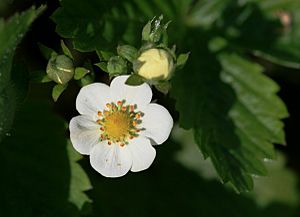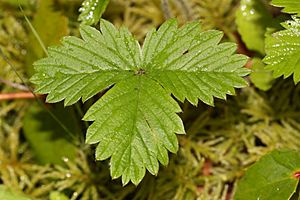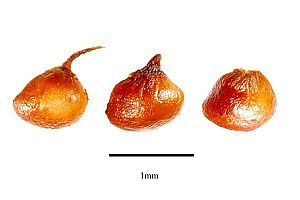Wild strawberry facts for kids
Quick facts for kids Wild strawberry |
|
|---|---|
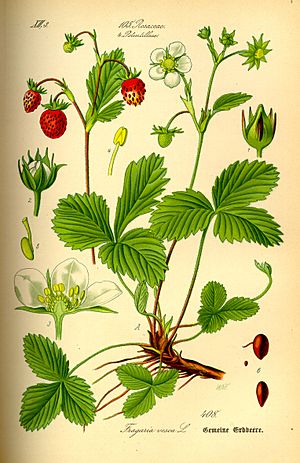 |
|
| Scientific classification | |
| Genus: |
Fragaria
|
| Species: |
vesca
|
Fragaria vesca, also known as the wild strawberry or woodland strawberry, is a small plant that lives for many years. It's part of the rose family. You can find it growing naturally across much of the Northern Hemisphere. This plant is famous for its tasty, edible fruits.
The scientific name vesca comes from Latin and means "thin" or "feeble."
Contents
What Wild Strawberries Look Like
Wild strawberry plants have soft, hairy white flowers. There are usually five to eleven flowers on a green stalk. This stalk is about 3 to 15 centimeters (1 to 6 inches) tall. It usually holds the flowers above the leaves.
The leaves are light green and divided into three parts. Each part has a jagged edge, like tiny teeth. Wild strawberries mostly spread using special stems called runners. These runners grow along the ground and can start new plants. The seeds can also grow into new plants.
Types of Wild Strawberries
Long ago, some people like Vilmorin-Andrieux (in 1885) saw a difference between wild strawberries (Fragaria vesca) and alpine strawberries (Fragaria alpina). However, today, most plant sellers call Fragaria vesca by the name "alpine strawberry."
Vilmorin described the wild strawberry as having a special smell and delicate taste. He noted that alpine strawberries were generally larger. They also produced flowers and fruit all summer long.
Wild Strawberry Subspecies
As of November 2020, there are two main types, or subspecies, of Fragaria vesca recognized. These are in addition to the main Fragaria vesca ssp. vesca:
- Fragaria vesca ssp. americana
- Fragaria vesca ssp. bracteata
Where Wild Strawberries Grow
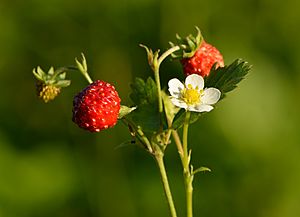
You can often find wild strawberries along trails and roadsides. They also grow on hillsides, in meadows, and at the edges of forests. They like places with some sunlight, but not too much, especially in warmer areas. They can grow in different amounts of moisture. Wild strawberries can even survive mild fires. They might start growing again after a fire.
Even though they mostly spread by runners, their seeds are also important. Seeds can stay in the soil for a long time. They often sprout when the soil is disturbed.
Wild strawberry leaves are a food source for animals like mule deer and elk. Many mammals and birds eat the fruit. When animals eat the fruit, they help spread the seeds in their droppings.
The plant is also a home for the larvae of a butterfly called the two-banded checkered skipper.
Why Wild Strawberries are Important for Science
| NCBI genome ID | 3314 |
|---|---|
| Ploidy | diploid |
| Number of chromosomes | 14 |
| Year of completion | 2010 |
The wild strawberry is a very useful plant for scientists. It's used as a "model plant" for studying other strawberry plants. It also helps scientists understand the whole rose family.
It's a good model plant because:
- Its genome (all its genetic information) is very small.
- It grows and reproduces quickly. It can go from seed to new seeds in about 14 to 15 weeks.
- It's easy to grow and make more of.
Scientists mapped out the wild strawberry's genome in 2010. They did an even more detailed map in 2017.
All strawberry species have seven chromosomes in their basic set. The wild strawberry is diploid. This means it has two sets of these chromosomes, making a total of 14.
History and Uses of Wild Strawberries
People have been eating Fragaria vesca since the Stone Age. This is known from things found at old archaeological sites.
Wild strawberry fruits have a strong, delicious flavor. People still gather them from the wild. They are also grown on a small scale for special foods and ingredients. These include jams, sauces, and even some cosmetics. In Turkey, many tons of wild fruit are picked each year. Most of these are sent to other countries.
Many types of cultivated wild strawberries are called "alpine strawberries." They produce fruit for a very long time. Their fruits are larger than those of the common wild strawberry. These plants are usually grown from seeds or by dividing the plant. The types grown in gardens often produce fruit all summer. They usually don't make many runners.
After a few years, these plants can become less strong. This is because they produce so many fruits and flowers. They can also get sick from plant viruses. Some types have been known since the 1700s. Some special types have white or yellow fruits when they are ripe, instead of red.
Some wild strawberry types that make runners are used as groundcover plants. Others that don't make runners can be used as border plants in gardens. Some types are grown just because they look pretty.
Scientists have also created new plants by mixing wild strawberries with garden strawberries. These are called Fragaria × vescana.
It's actually quite easy to grow alpine strawberries from seed. People sometimes think it's hard, but with care, about 80% of seeds can sprout in 1 to 2 weeks. They do best at about 21 degrees Celsius (70 degrees Fahrenheit).
Garden Varieties You Might Find
Here are some types of wild strawberries grown in gardens today:
- Grown from Seed
- Rügen: This was the first modern type. It doesn't have runners, produces fruit all summer, and has large fruits. It first appeared in Germany in 1920.
- Alexandria: First sold in the USA in 1964.
- Baron Solemacher: First sold in Germany in 1935.
- Weisse Solemacher: A type with white fruits.
- Golden Alexandria: This type has golden leaves.
- Other Cultivars
Some older types that produce runners can still be found in old gardens.
- Blanc Amélioré: A white-fruited type from Great Britain. It has rather large fruits.
- Illa Martin: From Germany, sold as an ornamental plant with white fruits.
- Gartenfreude: A large-fruited type from Germany.
See also
 In Spanish: Fragaria vesca para niños
In Spanish: Fragaria vesca para niños




